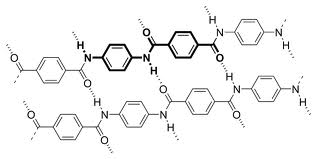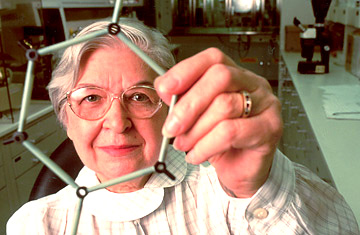|
Size: 978
Comment:
|
Size: 1393
Comment:
|
| Deletions are marked like this. | Additions are marked like this. |
| Line 13: | Line 13: |
| || 3.6 || % || max strain at break || || 2.4 || % || strength/tensile || |
|
| Line 16: | Line 18: |
| Kevlar [[attachment:KEVLAR_Technical_Guide.pdf | Technical Guide]] downloaded from !DuPont. | . A 14 km/s loop increases speed by 69 m/s over a 100 km descent. That is a stretch of 0.49%, 20% of the strength/tensile ratio . A 12 km/s loop increases speed by 80 m/s over a 100 km descent. That is a stretch of 0.67%, 28% of the strength/tensile ratio Kevlar [[attachment:KEVLAR_Technical_Guide.pdf | Technical Guide]] downloaded from !DuPont. Properties pdf page 9, thermal page 120 |
Kevlar
(Kevlar is a trademark of DuPont)
|
|
Kevlar is a high strength aramid fiber invented by Stephanie Kwolek in the 1960s, and sold by DuPont since 1971 |
Kevlar 49 Properties |
Kevlar in matrix, WAG |
|||
3 |
GPa |
breaking strength |
2 |
GPa |
124 |
GPa |
tensile modulus |
82 |
GPa |
1.44 |
g/cm3 |
density |
1.5 |
g/cm3 |
2.08 |
MYuri |
specific strength |
1.3 |
MYuri |
9.3 |
km/s |
longitudinal speed |
7 |
km/s |
212 |
km |
9.8 m/s² support length |
130 |
km |
3.6 |
% |
max strain at break |
||
2.4 |
% |
strength/tensile |
||
1.4 |
km/s |
max transverse speed |
||
110 |
$/kg |
cost (old citation) |
||
- A 14 km/s loop increases speed by 69 m/s over a 100 km descent. That is a stretch of 0.49%, 20% of the strength/tensile ratio
- A 12 km/s loop increases speed by 80 m/s over a 100 km descent. That is a stretch of 0.67%, 28% of the strength/tensile ratio
Kevlar Technical Guide downloaded from DuPont. Properties pdf page 9, thermal page 120


